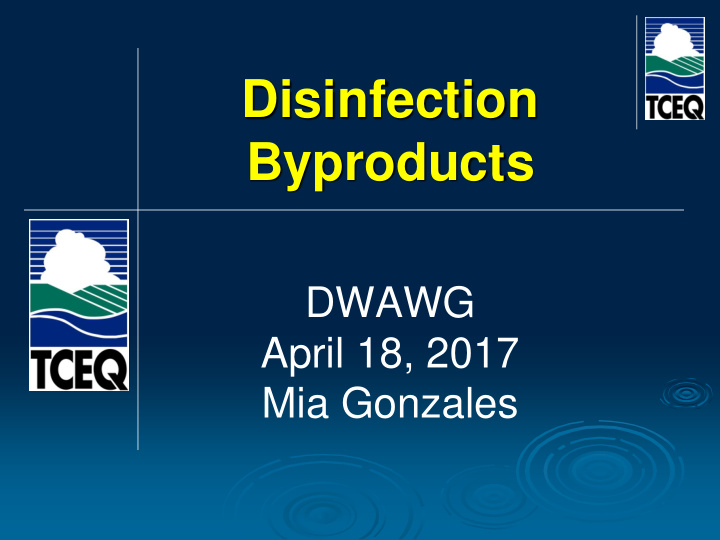



Disinfection Byproducts DWAWG April 18, 2017 Mia Gonzales
DBP Formation Four primary factors: • Disinfectant (type & amount) • Natural organic matter • Water age • Temperature
Stage 2 DBP Sampling • Number of sites based on water source and population. • DBP2 sites should represent areas with highest DBP levels or locations that are most likely to have elevated levels.
Stage 2 DBP MCLs Name MCL Trihalomethanes 0.080 mg/L Haloacetic Acids 0.060 mg/L Based on an average of results at each sample site (running annual average)!
Stage 2 DBP Compliance • Compliance based on locational running annual average (LRAA), §290.115(b)(1) • Generally use 4 consecutive quarters of monitoring but can calculate compliance using less than 4 quarters • Add the four most recent quarters of data for one sample site and divide by four Q1 + Q2 + Q3 + Q4 = Sum/4 = LRAA
Drinking Water Watch http://dww2.tceq.texas.gov/DWW/
DWW DBP2 Sample Locations
DWW DBP2 Results
Operational Evaluation Level Reporting The OEL Report is an evaluation of the water system meant to help you identify the cause of high DBP levels Q2 + Q3 + Q4 + Q4 = Sum/4 = OEL • Required if TTHM exceeds 0.080 mg/L or HAA5 exceeds 0.060 mg/L
How is the report organized? Source Disinfection Monitoring Distribution Future Water and Results System Actions Evaluation Treatment Summary $ Disinfectant (Q2+Q3+(Q4x2)) $ 4 Booster Disinfection Where’s the Temperature Time Time What are exceedance? you going to DBP Temperature Disinfectant do? Precursors Disinfectant Temperature Precursor Removal
DBP Statistics • 4.4% of PWS in 2016 had one or more DBP violations • 235 community • 9 non-transient non-community • 1,074 violations total • 409 have been returned to compliance • 665 are still active
DBP Questions Mia Gonzales (512) 239-6576 Mia.Gonzales@tceq.texas.gov DBP@tceq.texas.gov
Disinfection Byproducts ALEXANDER HINZ TCEQ WATER SUPPLY DIVISION DRINKING WATER ADVISORY GROUP APRIL 18, 2017
Disinfection Byproducts This presentation excludes chlorite and bromate Total Trihalomethanes (TTHM) Haloacetic Acid (HAA5) Chlorine + total organic carbon (TOC) = disinfection byproducts
TTHM Chloroform (forms slowly) Bromoform (brominated species form very quickly) bromodichloromethane dibromochloromethane
TTHM Brominated species contribute more to TTHM values when source waters have higher concentrations of bromide (e.g. source water exposed to marine or estuary intrusion and certain geological formations) Chloroform is usually more dominant when source water bromide levels are low pH, temperature and reaction time are big drivers in formation
Texas Drinking Water Watch You can view results on this publically available website: http://dww2.tceq.texas.gov/DWW/ Chemical results, sort by name
Texas Drinking Water Watch
Texas Drinking Water Watch
TTHM Brominated species can severely limit the application and effectiveness of free chlorine at a surface water treatment plant because of the limited exposure time needed for formation Chloroform can allow more flexibility when using free chlorine because of its nature to form more slowly
IMPORTANT! Surface water treatment plants (SWTP) are required to meet a certain disinfection protocol for the inactivation and/or removal of viruses, giardia and cryptosporidium. This protocol and subsequent parameters are outlined in the TCEQ approved Concentration Time ( CT) Study Flow through treatment units, detention time, pH, water temperature and disinfection type and concentration are major factors used to assess the effectiveness or success of pathogen removal
IMPORTANT! Chloramines are less aggressive with precursor organics responsible for forming TTHM and HAA5s but are approximately 20 times less effective as a disinfectant. Therefore, feeding chloramines at the head of a surface water treatment plant may not result in regulatory compliance with the inactivation and/or removal of viruses, giardia and cryptosporidium Must continue to meet turbidity requirements
Strategies for lowering TTHM’s Review previous sample results and determine dominant species (i.e. chloroform or brominated) Review disinfectant type(s) and application point(s) at SWTP and in distribution (e.g. how much contact time with chlorine before ammonia fed) Collect samples for TOC and TTHM’s at the different treatment units (for example after sedimentation recycle stream)
Strategies for lowering TTHM’s Limit or eliminate the use of free chlorine prior to sedimentation/clarification Remove as much of the organic precursors as possible before introducing chlorine compounds Use of alternate disinfectants such as chlorine dioxide or ozone (requires TCEQ approval and additional process monitoring/control protocols)
Strategies for lowering TTHM’s Enhanced coagulation Aluminum sulfate (alum) – Drive pH down to 5.5 – 6.5 This pH range allows for greater removal of organic matter through the sedimentation process Do not use free chlorine in distribution Ensure flushing is conducted at least once every 30 days or more frequently to reduce water age (emphasis on uni-directional flushing UDF). This is especially true for systems with high chloroform results. Increased water age can lead to higher TTHM values
Strategies for lowering TTHM’s Evaluate the installation of mixing/aeration equipment in ground and elevated storage tanks if the system is experiencing poor mixing and elevated chloroform levels Deep cycle storage tank(s) periodically Purchased water systems should not boost with free chlorine if the incoming water is chloraminated
Strategies for lowering TTHM’s Maintain proper pH for chloramines at the treatment plant and in the distribution Use good process monitoring and control techniques to determine your dosing strategies Having and implementing a good Nitrification Action Plan (NAP)
Wholesale Providers Be a good water wholesaler! Don’t sell water to another public water system just below the maximum contaminant level for disinfection byproducts Effective communication, coordination and cooperation is essential
Questions? Alexander Hinz TCEQ Water Supply Division 512-239-4720 Alexander .Hinz@tceq.texas.gov
Recommend
More recommend